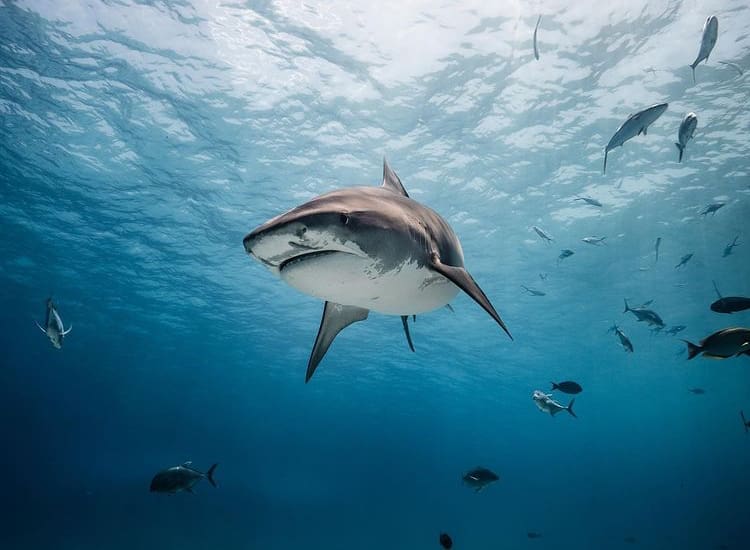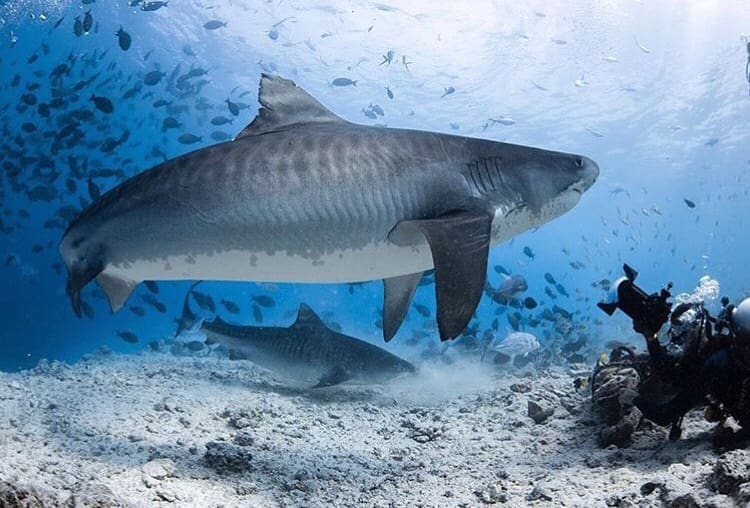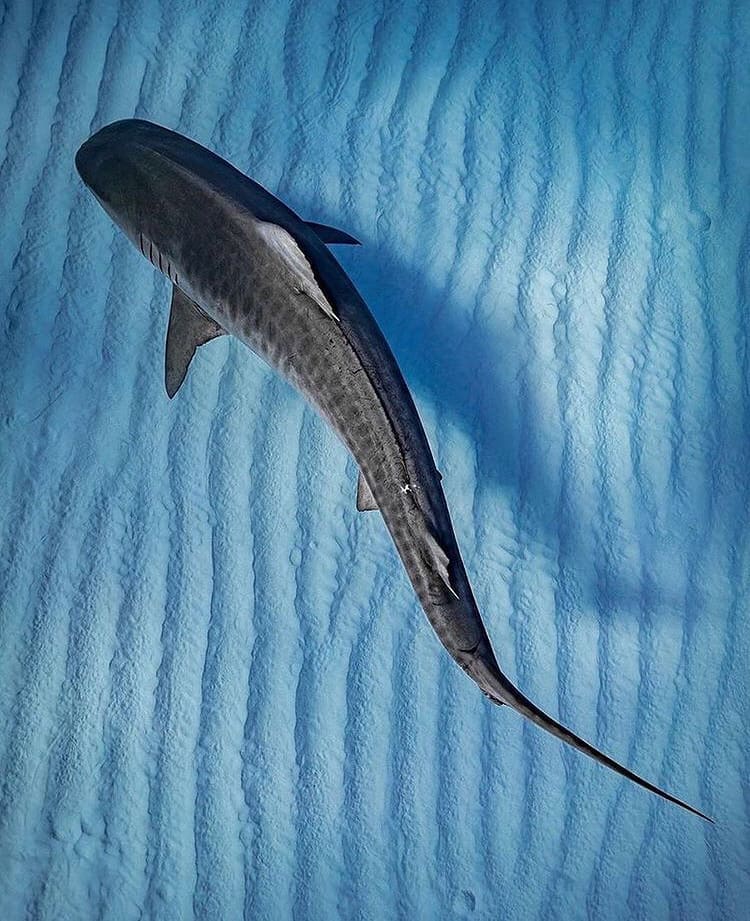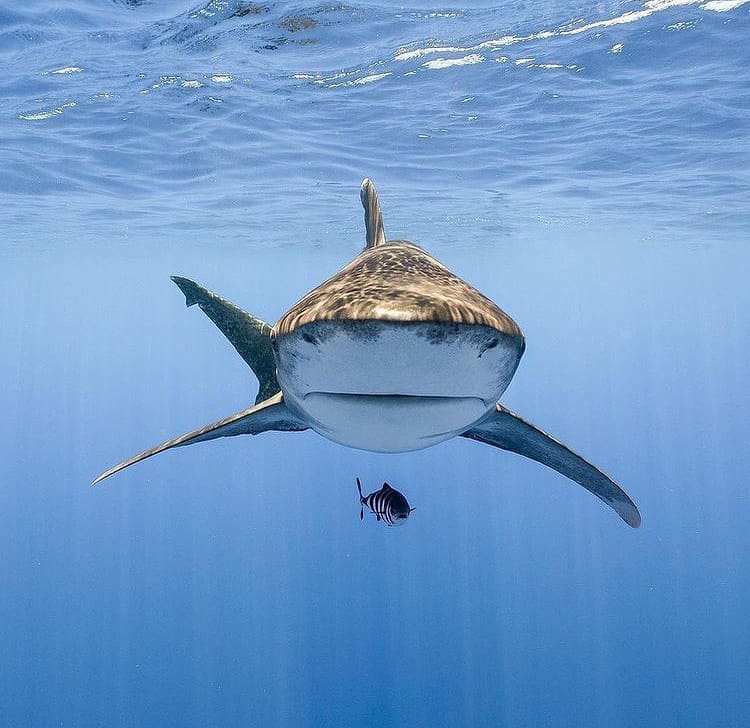[social_warfare]
One of the largest and most feared predators in the ocean, the Tiger Shark is among the most iconic animals in the sea.
What is the Tiger Shark?
The tiger shark is the fourth largest shark species in our oceans, after the whale shark, basking shark and the great white shark. They are the second largest of the true predatory shark species.
They are aggresive predators, known for eating almost anything. They are often referred to as the dumpsters of the sea.
Appearance
What do tiger sharks look like?
The tiger shark is a large, heavy-bodies animal with a sleek but intimidating appearance.
It has a wedge shaped head and blunt nose, which allows them to turn quickly from side to side. A must when hunting speedy rays.
They have two long pectoral fins, a large caudal (tail) fin and a sizeable dorsal fin. On their underside they also have a pair of pelvic fins and a single anal fin.

How big are tiger sharks?
The typical adult ranges between 10 and 15ft. (3.2-4.5 metres).
They are a dimorphic species which means there is no physical differences between males and females. The primary difference is size with females being the larger of the two sexes.
Mature females regularly grow over 12ft. (3.7m). Males almost never get that big.

The weight of an adult will vary according to its overall length and girth, but usually ranges between 800 and 1500lbs (350-700 kilograms).
Exceptionally large specimens do occur, and individuals have been recorded at more than 18ft. (5m) long and over 1 tonne in weight.
Stripes
The tiger shark is characterised by vertical markings down either side of its body. These mimic the stripes of the iconic big cat and is what inspired the tiger shark’s name. These dark bands fade as the animal grows.
Their skin is a bluish-grey on the upper half, while their underside is a varied white/cream colour.
As with all shark species, this colour adaptation helps with hunting as they are they are camouflaged from both above and below.

How many teeth do tiger sharks have?
Tiger sharks have a large mouth, filled with 48 razor sharp teeth.
These large teeth are broad and serrated, slanting backwards to allow for better grip when biting into the flesh of a prey item.

Most sharks have an upper jaw designed for cutting flesh and a lower jaw designed for grip. However with tiger sharks, there is no difference between the upper and lower jaws, which is what makes them even better equipped for hunting.
Unlike mammalian predators – including humans – who have different shaped teeth for different purposes, all of the tiger shark’s teeth are identical. All of which have a flattened rear half, designed for sawing through hard substances like a turtle’s shell.

Gills
Like all sharks, the tiger shark has five distinctive gills on either side of it’s head. These allow the filtration of water and extraction of oxygen into the shark’s bloodstream.
Behaviour
What do tiger sharks eat?
Tiger sharks are carnivorous in nature, and are notorious for consuming anything they can get their mouths around. Common prey items include; fish, birds, sea turtles, seals, squid and even other sharks.
They are often referred to as the ‘garbage bin of the seas’ and individuals, ironically, have even been found with metal objects and garbage in their gut. These have even included car license plates, and parts of tyres.

Their diet varies with geographic location, and they’re even known to be more likely to attack humans in certain areas. Although it has never been proven that they actively seek out humans as a source of food.
They will also scavenge off floating whale carcasses, and despite being a veracious predator, they’re able to go several weeks without food.
Hunting
Tiger sharks are solitary hunters, usually doing so under the cover of darkness. They have incredibly well-adapted eye sight and hearing, which helps them detect prey in the dark.
They have a mirror-like covering behind their retina which is called ‘tapetum lucid’. This reflects light that has already been seen by the retina back at it, allowing for better vision in the darkness.
Along their sides they have small pits that hold what’s called the ‘ampullae of lorenzini’. These are highly-adapted sensors that allow them to detect even the slightest muscle movements made by other animals in the water.
Not only are tiger sharks one of the most aggressive shark species, they are also very curious. Once they have located a potential prey item, they slowly approach from below, often times even circling before moving going in for the kill.
Their colouration allows them to get close before being noticed, while their size, power and speed help seal the deal. Tiger sharks are also known to investigate by bumping prey items with their nose before biting.
Social Structure
The tiger shark is a solitary fish that usually doesn’t associate with any other shark species, except in select locations. Smaller sharks will avoid them at all costs, due to their cannabilistic nature. Adult tiger sharks only come together to mate.
Once born, baby tiger sharks will spend no time with their mothers and will actively flee to avoid being eaten.
Habitat & Range
Where do tiger sharks live?
The tiger shark is a heat-loving species, found in most warm, tropical oceans.
They are a nomadic species, and their movements are guided by the temperature of the currents. During the winter months they stay closer to the equator, before moving off during warmer parts of the year. They’re known to travel thousands of miles each year during their migrations.
They prefer to live in deep waters, just off of coral reefs, feeding along the outskirts or venturing in when needed. However they also frequently move into shallow waters, harbours or estuaries, where most of their contact with humans occurs.
Tiger sharks are found in warm seas across the entire southern hemisphere. They are most commonly seen in: North America, Hawaii, The Bahamas, South Africa, Maldives, New Zealand, Mexico, Australia, Fiji and Indonesia.
Conservation
How many tiger sharks are their in the world?
Due to their vast geographic range and nomadic nature, it is incredibly difficult to survey the amount of tiger sharks in the ocean. Therefore the exact number is unknown.
Is the tiger shark endangered?
The tiger shark is currently listed as ‘Near Threatened’ on the IUCN red list, and is at risk of becoming vulnerable should their population continue to decrease.
Threats to the tiger shark
The primary threats facing tiger sharks today are those of the human kind. Shark finning, commercial fishing and climate change have all contributed to the declining tiger shark population.
Tiger sharks have a low reproduction rate and when youngsters fall victim as bycatch of commercial fisheries, this is extremely detrimental to the next generation.
DIVING
Despite the threat that tiger sharks pose to humans, they are one of the most common shark species that people look for and free dive with.
Tour companies operate tiger shark specific excursions in all the population hot spots. These allow you to dive with these incredible beasts alongside experienced professionals.
Here are the best places on earth to dive with tiger sharks:
- Bimini, The Bahamas
- Protea Banks, South Africa
- Hawaii, USA
- Beqa Island, Fiji
Facts About The Tiger Shark
- Scientific name – Galeocerdo cuvier
- Bite pressure – The tiger shark’s bite pressure can be more than 6,000 pounds per square centimetre (3,300kg p/sqm)
- Man-eater – Often called the ‘man-eater’ shark, the tiger shark is second only to the Great White for the number of human fatalities. There is no proof to suggest that tiger sharks hunt humans for food.
Myths About The Tiger Sharks
- Hunting humans – The most common myth surrounding sharks is that they actively hunt humans. This has proven to be false. Humans come into contact with sharks very often (usually unknowingly) and attacks are extremely rare.
- Tiny brains – Sharks do not have tiny, walnut-sized brains as is commonly believed. In fact, they actually have fairly large brains comparative to their body size.
- Movement – It has long been thought that tiger sharks cannot stop moving or they will die. This has been proven false in tiger sharks and a number of other species who are able to use ‘buccal pumping’. This is the use of cheek muscles to actively inhale water through their gills. The mako, great white and whale shark are a few species who cannot use buccal pumping and need to keep moving to allow water to flow through their gills.
- Fin re-growth – Shark finning is a massive industry in Asia, and is one of the most exploitative and inhumane practices on earth. Many industry players spread false propaganda, leading people to believe that a shark’s fins will grow back once cut off. This is entirely false, and cutting off a shark’s fins is a death sentence.






